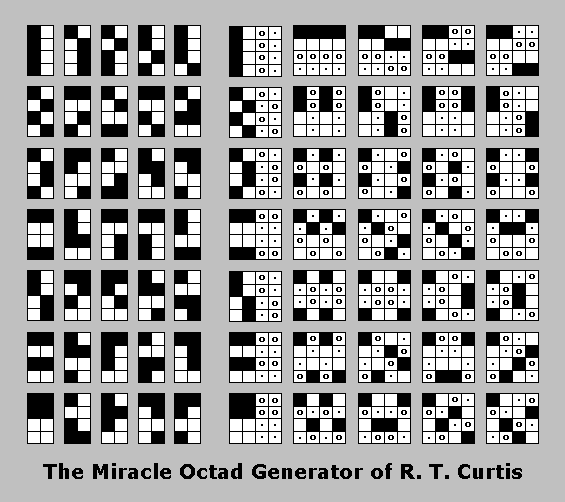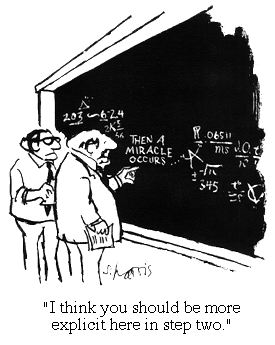For a Kaleidoscopic Structuralist —
Adapted from a Log24 post of October 25, 2006.
A revision of the above diagram showing
the Galois-addition-table structure —

Related tables from August 10 —

See "Schoolgirl Space Revisited."
"I need a photo opportunity, I want a shot at redemption.
Don't want to end up a cartoon in a cartoon graveyard."
– Paul Simon
From the previous post —

From a cartoon graveyard —

See also, in this journal, Smallest Perfect and Nocciolo .
In memory of an actor “who as a boy was one of the few Jewish children
in his mostly Italian-American neighborhood in Brooklyn” —
See the link nocciolo from The Book of Abraham (Oct. 7, 2013).
Compare and Contrast
A rearranged illustration from . . .
R. T. Curtis, "A New Combinatorial Approach to M24 ,"
Mathematical Proceedings of the Cambridge Philosophical Society ,
Volume 79 , Issue 1 , January 1976 , pp. 25 – 42
DOI: https://doi.org/10.1017/S0305004100052075 —


The "Brick Space" model of PG(5,2) —

Background: See "Conwell heptads" on the Web.
See as well Nocciolo in this journal and . . .

From a search in this journal for nocciolo —
From a search in this journal for PG(5,2) —

From a search in this journal for Curtis MOG —
Shown above is a rearranged version of the
Miracle Octad Generator (MOG) of R. T. Curtis
("A new combinatorial approach to M24,"
Math. Proc. Camb. Phil. Soc., 79 (1976), 25-42.)
From a search in this journal for Klein Correspondence —

The picture of PG(5,2) above as an expanded nocciolo
shows that the Miracle Octad Generator illustrates
the Klein correspondence.
Update of 10:33 PM ET Friday, July 5, 2024 —
See the July 5 post "De Bruyn on the Klein Quadric."
For related material on the geometry of a 2×3 rectangular array —
a domino — see the previous post and also a search in this journal for attic .
Related literary notes — On April 28 The New York Times
reported a death from the above date (Tuesday, April 26, 2022).
See a followup in the Times today on "New York literary royalty."
The above New Yorker art illustrates the 2×4 structure of
an octad in the Miracle Octad Generator of R. T. Curtis.
Enthusiasts of simplicity may note how properties of this eight-cell
2×4 grid are related to those of the smaller six-cell 3×2 grid:
See Nocciolo in this journal and . . .

Further reading on the six-set – eight-set relationship:
|
<title data-rh="true">Frank Heart, Who Linked Computers Before the Internet, Dies at 89 – The New York Times</title> |
See also yesterday's "For 6/24" and …
My statement yesterday morning that the 15 points
of the finite projective space PG(3,2) are indivisible
was wrong. I was misled by quoting the powerful
rhetoric of Lincoln Barnett (LIFE magazine, 1949).
Points of Euclidean space are of course indivisible:
"A point is that which has no parts" (in some translations).
And the 15 points of PG(3,2) may be pictured as 15
Euclidean points in a square array (with one point removed)
or tetrahedral array (with 11 points added).
The geometry of PG(3,2) becomes more interesting,
however, when the 15 points are each divided into
several parts. For one approach to such a division,
see Mere Geometry. For another approach, click on the
image below.
Meets the Kernel in the Nutshell.
This post was suggested by the title of Natalie Wolchover’s
article in Quanta Magazine today,
“A Fight for the Soul of Science.”
The post continues a meditation on the number 6
as the kernel in the nutshell of 15.
For an illustration of the 6 in the 15,
see nocciolo in this journal.
For an illustration of the jewel in the lotus,
see that phrase in this journal.
See a search for Nocciolo in this journal.
An image from that search —
Recall also Hamlet's
"O God… bad dreams."
Or: The Nutshell

What about Pascal?
For some background on Pascal's mathematics,
not his wager, see…
Richmond, H. W.,
"On the Figure of Six Points in Space of Four Dimensions,"
Quarterly Journal of Pure and Applied Mathematics ,
Volume 31 (1900), pp. 125-160,
dated by Richmond March 30,1899
Richmond, H. W.,
"The Figure Formed from Six Points in Space of Four Dimensions,"
Mathematische Annalen ,
Volume 53 (1900), Issue 1-2, pp 161-176,
dated by Richmond February 1, 1899
See also Nocciolo in this journal.
Recall as well that six points in space may,
if constrained to lie on a circle, be given
a religious interpretation. Richmond's
six points are secular and more general.
On Abraham Nemeth, the developer of Braille
for blind students of mathematics —
"… he began tinkering with the six-dot cell
that is the foundation of Braille."
For a different six-dot cell, see Nocciolo .
"Throughout his life, he dedicated much of his
spare time to creating Braille versions of Jewish
texts, including helping to proofread a Braille
Hebrew Bible in the 1950s." — Nemeth's obituary
Those who prefer entertainment may consult The Book of Eli.
"The yarns of seamen have a direct simplicity, the whole meaning
of which lies within the shell of a cracked nut. But Marlow was not
typical (if his propensity to spin yarns be excepted), and to him the
meaning of an episode was not inside like a kernel but outside,
enveloping the tale which brought it out only as a glow brings out a
haze, in the likeness of one of these misty halos that sometimes
are made visible by the spectral illumination of moonshine."
— Joseph Conrad in Heart of Darkness
Kernel — See Nocciolo.
Glow — See Moonshine and Moonshine II.
See also Cold Open (Jan. 29, 2011) and
Where Entertainment is God (Aug. 25, 2013).
"The proof of Desargues' theorem of projective geometry
comes as close as a proof can to the Zen ideal.
It can be summarized in two words: 'I see!' "
— Gian-Carlo Rota in Indiscrete Thoughts (1997)
Also in that book, originally from a review in Advances in Mathematics,
Vol. 84, Number 1, Nov. 1990, p. 136:
Related material:
Pascal and the Galois nocciolo ,
Conway and the Galois tesseract,
Gardner and Galois.
See also Rota and Psychoshop.
The geometry posts of Sunday and Monday have been
placed in finitegeometry.org as
Classical Geometry in Light of Galois Geometry.
Some background:
See Baker, Principles of Geometry , Vol. II, Note I
(pp. 212-218)—
On Certain Elementary Configurations, and
on the Complete Figure for Pappus's Theorem
and Vol. II, Note II (pp. 219-236)—
On the Hexagrammum Mysticum of Pascal.
Monday's elucidation of Baker's Desargues-theorem figure
treats the figure as a 154203 configuration (15 points,
4 lines on each, and 20 lines, 3 points on each).
Such a treatment is by no means new. See Baker's notes
referred to above, and
"The Complete Pascal Figure Graphically Presented,"
a webpage by J. Chris Fisher and Norma Fuller.
What is new in the Monday Desargues post is the graphic
presentation of Baker's frontispiece figure using Galois geometry :
specifically, the diamond theorem square model of PG(3,2).
See also Cremona's kernel, or nocciolo :

Baker on Cremona's approach to Pascal—
"forming, in Cremona's phrase, the nocciolo of the whole."

A related nocciolo :
Click on the nocciolo for some
geometric background.
Powered by WordPress